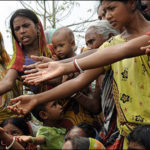 One of the most difficult challenges facing the Indian state has been the inability to deliver resources to where needs exist. Thousands go hunger while food grains rot in storage facilities, enrolment rates are dismally low in Government schools even after education has become a fundamental right, medical facilities for rural population are lacking even while Government invests in providing affordable primary health care. As Pratap Bahnu Mehta observes, “there is little in the citizens’ experience of the Indian state that leads them to believe that the state will be a credible provider of social services.” Thus the launch of another central sector scheme (CSS) does not create much enthusiasm among the citizens. It is expected that much like existing schemes, the new ventures will be stymied in clientelism, patronage and corruption. However, in a marked departure to the prevailing approach, the UPA is considering a phased move to direct cash transfers in public distribution system (PDS). Can this approach change the way in how government spending impacts social welfare?
One of the most difficult challenges facing the Indian state has been the inability to deliver resources to where needs exist. Thousands go hunger while food grains rot in storage facilities, enrolment rates are dismally low in Government schools even after education has become a fundamental right, medical facilities for rural population are lacking even while Government invests in providing affordable primary health care. As Pratap Bahnu Mehta observes, “there is little in the citizens’ experience of the Indian state that leads them to believe that the state will be a credible provider of social services.” Thus the launch of another central sector scheme (CSS) does not create much enthusiasm among the citizens. It is expected that much like existing schemes, the new ventures will be stymied in clientelism, patronage and corruption. However, in a marked departure to the prevailing approach, the UPA is considering a phased move to direct cash transfers in public distribution system (PDS). Can this approach change the way in how government spending impacts social welfare?
Cash transfer approach has supporters in the political, administrative and academic circles. Delhi Chief Minister Sheila Dixit and Bihar Chief Minister Nitish Kumar have been ardent advocates of the approach. Chief Minister Dixit’s government has argued for cash transfer in lieu of giving subsidized food and fuel. According to Chief Minister Nitish Kumar the direct cash transfers in his effort to give Bihar’s girls bicycles had a “92 per cent success rate”. He went on to argue that cash transfers would “plug a lot of leakages in the [food] distribution system as well, as the PDS is not working really. Also it will give the poor an option in terms of their spending.”
Kaushik Basu, Chief Economic Advisor to Government of India, has also proposed food coupons and cash transfers in his paper on the Economics of Foodgrain Management in India. According to Basu “the subsidy should be handed over directly to the poor household instead of giving it to the PDS shop owner with the instruction that he or she transfer it to the poor. This can be done by handing over food coupons to BPL households, which they can use as money to buy food from any store. The store owner can then take the coupon to any bank and change it back for cash.” Basu also details the auxiliary approaches to plug the loopholes in the coupon distribution and utilization process and favors dovetailing it with the UID program. As a variant of the food coupon, Montek Singh Ahluwalia, Deputy Chairman of Planning Commission, suggested the use of smart cards. A smart card system would allow the PDS shop to sell the grain at unsubsidised price but the poor get a smart card which credits the shopkeeper with the subsidy amount and what the customer pays is the subsidised price.
Devesh Kapur, Partha Mukhopadhyay and Arvind Subramanian highlight the deficiencies of the existing public distribution scheme in a paper entitled, The Case for Direct Cash Transfers to the Poor. As a corrective the authors suggest that expenditure on social welfare should be redirected in principally two ways, a) a scheme of outright transfers to individuals and b) a quantum increase in flow of funds to local governments.
Duplication and misuse of coupons are cited as potential deal breakers for the proposed direct transfers approach. If use of currency notes is not ruled out in spite of circulation of counterfeit currency, it is naïve to rule out use of coupons due to the possibility of duplication. Some critics suggest that coupons can be misused by recipients if they choose to sell it and use the cash elsewhere. This same rationale can be applied to food and other items provided by the PDS.